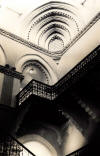|
|
the-south-asian.com January - March 2009 |
|
|||
|
Five Main Targets - CST
Taj
- Mumbai's
|
|
||||
|
The Taj Palace Hotel – Mumbai's much-loved icon When Taj opened in 1903 – as the finest hotel in the East – fifty ruling princes checked in at once. One actually brought a pet tiger with him. In 1903 Jamsetji Tata built one of the finest hotels in the world – the Taj Mahal Hotel in Bombay. Built for the love of the city, it, in turn, became the city’s most loved icon. The hotel was far ahead of its time and excelled in service – even that of Shepheards in Cairo and Raffles in Singapore. None equalled the Taj in luxury, ambience and service. The widely travelled Jamsetji, who, by then, had already founded his Tata empire, spared neither energy nor means to create his dream hotel. Indian architect, Sitaram Khanderao Vaidya, died before the building was finished. Tata's architect friend WA Chambers completed the building, retaining nearly all Vaidya's original features. The first super-luxury Indian-owned hotel had American ceiling fans, German elevators, Turkish baths, English butlers, a permanent orchestra, European management and staff, French chef, and the room tariff was - Rs 6 upwards! The Taj Hotel was the first commercial building in Bombay to be electrified. While the hotel was being constructed, Jamsetji visited an exhibition in Dusseldorf and contracted a German firm to electrify the hotel at a cost of 2 annas per unit. The quality-conscious and perfectionist Jamsetji Tata took personal care in furnishings and interiors. He died in 1904 – a year after the hotel opened its doors to its guests. Story has it that Jamsetji was once refused entry into one of the finest hotels in Bombay on racial grounds – and that’s when he made up his mind that he would build the finest hotel in the world which would be open to visitors and guests of all races. The design of the finished structure, with its entrance not facing the sea-front but at the back-side, came under a lot of speculation and criticism. The architect’s logic was simple – the U-shaped wings of the hotel were meant to provide most of the guests with rooms overlooking the sea. The Taj Mahal Hotel, seen from outside, is not an architectural marvel. Elements from various traditions of architecture have been put together in a structure the size of two city blocks. Inside – is a different story. The overwhelming grandeur of
its interiors – the
Associated with the rich, the famous, and the powerful, Taj hosted banquets on the state visits of the Prince of Wales and Princess Mary in November 1905, and again on their second visit in December 1911 – this time as King George V and Queen Mary – and for Edward Prince of Wales in November 1921. Taj was also where Nehru, Jinnah, Sarojini Naidu, and Subhash Chandra Bose met to shape India’s destiny. When Taj opened in 1903 – as the finest hotel in the East – fifty ruling princes checked in at once. One actually brought a pet tiger with him.
Not known to many is that the Taj Hotel group has one of the most impressive collections of contemporary Indian art. Works of Jamini Roy, Tyeb mehta, N S Bendre, K H Ara, Jehangir Sabavala, M F Husain, K K Hebbar, Laxman Pai, B Prabha, B Vithal, Jatin Das, Anjoli Ela Menon, and Bose Krishnamachari, are displayed in corridors, public spaces and suites – so are sculptures and artefacts. The ‘Tree of Life’, which now stands next to the memorial tablet in the lobby of the Taj Tower (post November 26 attacks in Mumbai), used to be on the sixth floor of the Heritage (the original) wing. It is an outstanding piece of tribal art, ten feet high, in metalwork by Jai Dev. Taj has a tradition of the best chefs in the country. The first chef in 1903 was French. Then came the era of Michelin-starred chefs. Arvind Saraswat, Subhash Basrur, ‘Nat’ Natarajan, Maria Vez are the celebrity chefs who have prepared gastronomic wonders here – several Taj-trained chefs have opened their own restaurants in the UK and won the coveted Michelin stars. The Zodiac Grill, when it opened, was considered the best restaurant in the country. The menu carried no prices – the guests paid what they thought the meal was worth. However, the prices were added a year later. The adjoining Taj Tower, designed by Dale Keller, was built in the 70s and opened India’s first Sichuan restaurant – Golden Dragon. The tradition of Indian food is relatively recent. Wasabi by Morimoto was acclaimed as the best Japanese restaurant. However, it was badly damaged in the recent attack on the hotel, and so was the Harbour Bar below - where the battle with the terrorists ended. All four were dead in the Harbour bar -facing the Gateway of India! The Zodiac Grill, when it opened, was considered the best restaurant in the country. The menu carried no prices – the guests paid what they thought the meal was worth. ***** |
|||||
|
Copyright © 2000 - 2009 [the-south-asian.com]. Intellectual Property. All rights reserved. |
|||||


